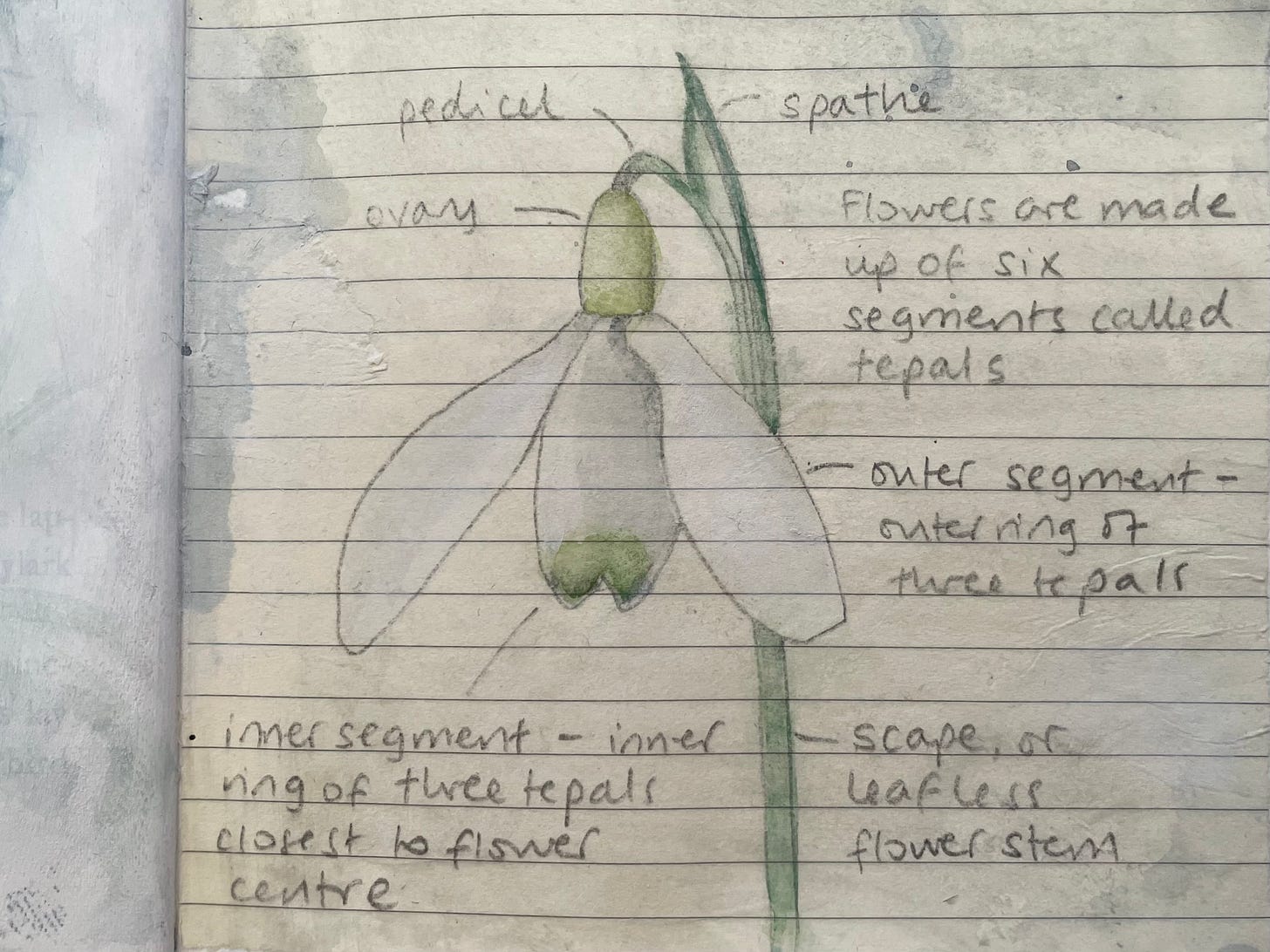
Dear Reader,
Our parents had given us each a pocket of garden to call our own: two rectangular beds around located against the east-ish facing wall of the house.
In my brother’s section was a beautifully-scented ‘Queen Elizabeth’ rose, whereas mine had two permanent features: an ‘Iceberg’ rose bush with bright-white blooms, and in the back right-hand corner a winter jasmine with its bold yellow flowers brightening the short, dark days from before Christmas right through until early spring. A proliferation of nasturtiums would reappear relentlessly summer after summer, and they were pretty in their way. They had rampant orange flowers, and I’d pick their leaves to float on the pond, pretending they were lily pads.

The trouble with nasturtiums is their irresistibility to cabbage white butterflies, which would shun the delights of the brassica beds in the vegetable garden and head straight for my nasturtiums on which to lay their tiny yellow eggs. Those would hatch into wriggly little larvae which would grow and grow into large, foul-smelling green and black caterpillars.
🐛
Reader, with rampant plants like these and their proliferation of uninvited guests, little Rebecca didn’t like gardening.
However, I have grown up learning that some plants can thrive without taking over quite so much space within a season, attracting no revolting pests and whose appearance in the very depths of winter brings light and hope into a grey garden.
Here is a February favourite of mine:
🌱
The Snowdrop Fairy
by Cicely Mary Barker
Deep sleeps the winter,
Cold, wet and grey;
Surely all the world is dead;
Spring is far away.
Wait! The world shall waken;
It is not dead, for lo,
The Fair Maids of February
Stand in the snow!
🌱
My identity as the single member of my family without green fingers doesn’t preclude me from enjoying plants and getting involved in the occasional horticultural project. In the middle of January I found myself part of a three-strong working party in my parents’ garden on a mission to plant a hundred tulips.
I was required for a job of strength, not expertise. I was to make holes using a bulb-planting tool designed to remove a plug of soil from the ground at a depth which Dad had shown me. Instead of pushing the plug out of the tool each time, I would move on to the next hole to dig, whose plug would ease the previous chunk of soil up and out of the conical aperture and onto the ground beside the hole.
I worked in sets of five holes in assorted configurations, following Mum’s directions as to where to start the next group, her intention being that flushes of flowers would be spread in natural-looking swathes across the meadow later in the year.
Armed with a trowel, Dad would drop a small amount of compost into each hole to create a comfy bed for the bulb. Mum followed behind, popping one of the tiny tulip bulbs into each hole, and once all five holes in a set had been populated Dad would add more compost. Finally, one of us would slice the bottom half off each plug of removed soil and tuck the top half, complete with its soft cap of turf and moss, into the hole.
As the task went on it began to get more difficult to see where we’d been. Of what once had been multiple sets of five holes there was barely a sign, the turf caps having been so expertly reinstalled.
The bulbs had been ordered back in August, when spring was both a distant memory and too far into the future to imagine. The supplier had sent them in October, and the postman had been briefed to put the box in the rear porch of the house if he found nobody in, my parents not wanting to give their spring promise a head start on growth by being left out in the rain.
Although the recommended planting time for Tulipa batalinii ‘Red Hunter’ was October/November, along with the British autumn had come a deluge which barely paused until Christmas, and tiny bulbs planted into sodden soil would not have stood a chance. In their box in the back porch they remained, ‘pause’ button pressed.
Yet as we discovered during our January working party the plucky tulip bulbs had already begun to sprout: a tiny, fleshy cone of growth at the top of each. It was for that reason that Mum was placing each bulb so carefully into its hole with its shoot positioned vertically.
Thanks to the tardiness of our task there were some surprises in store for the hole digger, and more than once I unearthed sprouting snowdrops, their shoots only just beneath the soil. These beautiful, pure white and green flowers, the very first to appear in a new year garden, are a sign of hope and promise in the dark days of winter.
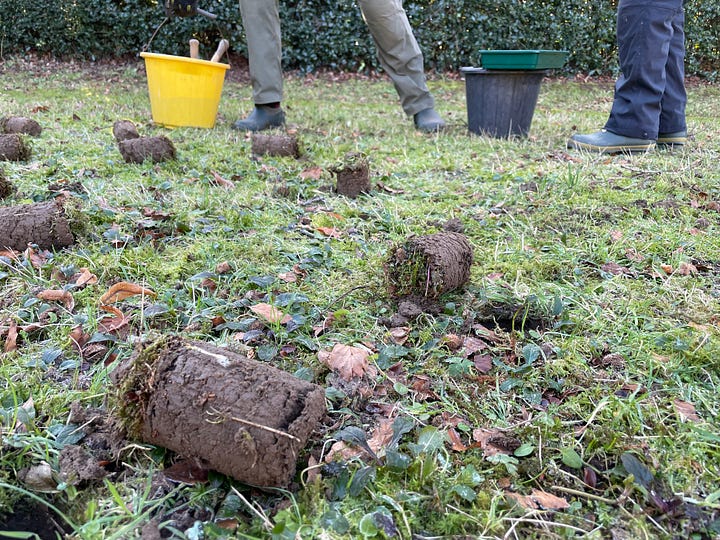

I’d been excited about the prospect of the first snowdrops in our own front garden, which had been reclaimed from a state of wilderness only a year and a half ago. We lived with it for a bit while we decided what we’d like to plant.
‘Would you like some of our snowdrops?’ Mum had asked us last spring, after hers had finished flowering. ‘You can plant them “in the green”, and they’ll come up early next year.’
I thought about my track record, then glanced at the bare soil outside the window. Reader, I had nothing to lose.
‘Yes please!’
And now, nearly a year later, I’m enjoying the sight of Cicely Mary Barker’s fair maids of February against the grey background of a no-snow winter, the last of the dried-up autumn confetti on the ground and new leaves of the can’t-remember-what-we-planted-heres springing up in gentle reminder of what’s to come.
And by May in my parents’ garden, well, I hope there will be tulips.
🌷🌷🌷🌷🌷
Perhaps even a hundred of them.
Love,
Rebecca
Artist’s notes
Reader, it’s hard to be inspired by the natural world when it’s all so gloomy outside, which is ironic, given that I’d hoped to bring some light into the grey gloom of winter with this post.
Examining a snowdrop I found its structure to be absolutely fascinating, and for this reason I chose a ‘Field Notes’ approach to this month’s spread in my art journal.
I’m more confident with the representation of more solid objects in my art projects, and I find flowers very difficult to draw and paint. The snowdrop was no exception, but I enjoyed adding the names of its parts to my diagram on the lined-paper side of the spread, and making a simple representation of the flower on the right-hand side gave me the impetus to stop dragging my feet to paint the specimen on the left!
I wanted to get across the grey appearance of our dark February garden, which is looking rather bleak save for the winter-white flashes of our long-awaited snowdrops.
📚 Reading 📚
📚 Right, how about some COLOUR after all that grey? This week I’ve thoroughly enjoyed checking out the vibrant and engaging abstract art of
of , and I hope you’ll do the same!📚 This terrific post by
of was one of my favourites this week. Irresistibly heartwarming, this adventure with a twenty-dollar bill is proof indeed that what goes around comes around.📚 Regular readers of ‘Dear Reader, I’m Lost' will be no strangers to my ongoing light-hearted correspondence with fellow Brit
of Eclecticism: Reflections on literature and life. It’s his turn to reply to me next Wednesday, and I really can’t wait! 😆Here’s his latest ‘Start the week’ to whet your appetite:
If you’ve enjoyed reading this post, the latest in a monthly series exploring some of my memories in words and pictures, please let me know by clicking the heart. Thank you! You’ll find all the posts in this ‘Art & Treasures’ series here.

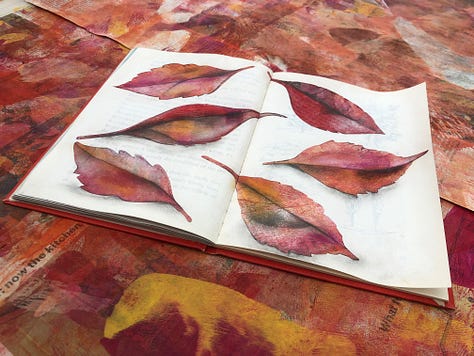


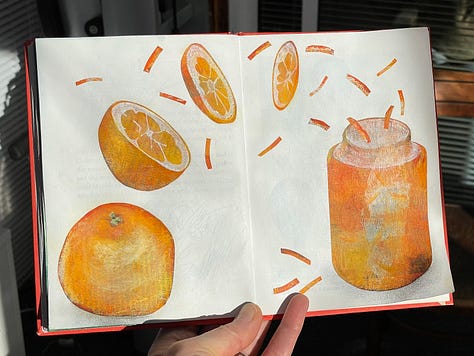
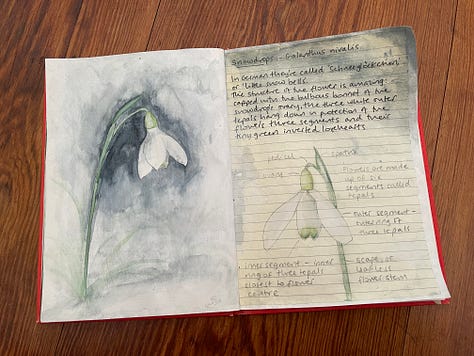
Thank you for reading! If you enjoy ‘Dear Reader, I’m lost’, please share and subscribe for free.

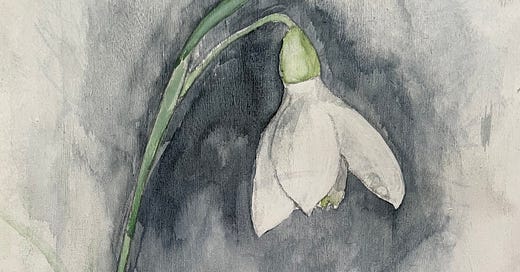










What an informative and charming post - your notebook (and I'm about to date myself horribly here) reminds me very much of The Country Diary of an Edwardian Lady. https://www.penguinrandomhouse.ca/books/643064/the-country-diary-of-an-edwardian-lady-by-edith-holden/9780847858903
I love those kind of watery, shimmery images. Also, here in darkest Canada where I live, we have a particularly brave snowdrop that pops up every year in a crack by the fence and is a reliable sign of spring. Freakishly, I just noticed it was up yesterday which is INSANELY early and quite distressing. I have taken to recording when this happens each year in a book of my own (not nearly as lovely as yours obvs) and this is the earliest ever which is distressing climate-news. But to end on a top note - loving your writing and stack and very pleased to discover you :)
Your mother is inspired! I can't wait to see tulip pics but in the meantime, I do love your snowdrops. I hadn't realised till a few years ago that there were so many different species of snowdrops and how superb they are. There's one I love whose little petals fly up like the Flying Nun's cornette veil - I have no idea of its botanical name.
Actually, I think I'll plant a little tub of galanthus and call them Rebecca in honour of the joy I always get from your essays - especially the Art Journal posts.
Take care, Rebecca and PS: I think I fixed the switch on the back-end. I hope...